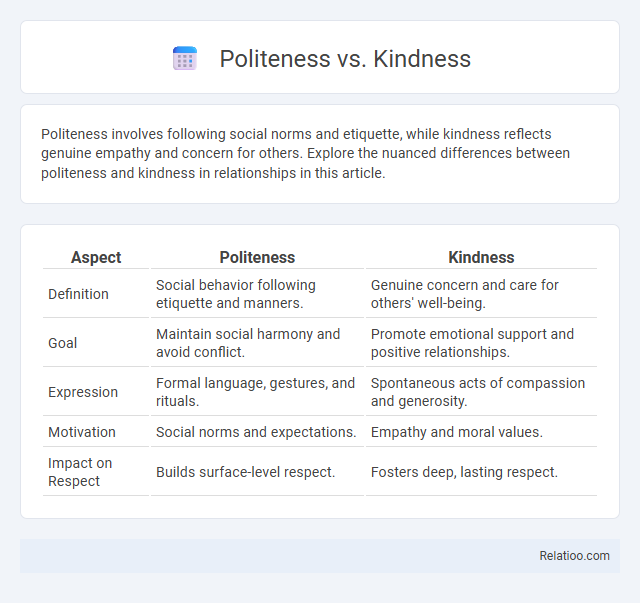Politeness involves following social norms and etiquette, while kindness reflects genuine empathy and concern for others. Explore the nuanced differences between politeness and kindness in relationships in this article.
Table of Comparison
| Aspect | Politeness | Kindness |
|---|---|---|
| Definition | Social behavior following etiquette and manners. | Genuine concern and care for others' well-being. |
| Goal | Maintain social harmony and avoid conflict. | Promote emotional support and positive relationships. |
| Expression | Formal language, gestures, and rituals. | Spontaneous acts of compassion and generosity. |
| Motivation | Social norms and expectations. | Empathy and moral values. |
| Impact on Respect | Builds surface-level respect. | Fosters deep, lasting respect. |
Understanding Politeness: More Than Good Manners
Understanding politeness involves recognizing it as a social tool that facilitates smooth interactions by adhering to cultural norms and etiquette, distinct from kindness, which reflects genuine compassion and care for others. Politeness often emphasizes formality and respect through language and behavior, while kindness prioritizes empathy and altruism irrespective of social expectations. Differentiating politeness from kindness helps navigate social dynamics effectively, ensuring interactions are both respectful and sincerely considerate.
The Essence of Kindness: Heartfelt Acts
Kindness, rooted in genuine empathy and compassion, transcends mere politeness by inspiring heartfelt acts that nurture well-being and foster deep human connections. While politeness involves adhering to social norms and etiquette, kindness expresses an authentic concern for others' happiness and comfort through selfless actions. True kindness emerges from sincere intentions, creating lasting positive impacts beyond superficial courteous behavior.
Politeness vs Kindness: Core Differences
Politeness involves adhering to social norms and etiquette to show respect, whereas kindness stems from genuine compassion and a desire to help others without expecting anything in return. Your actions can be polite without being kind, such as using courteous language while lacking empathy. Understanding these core differences helps you build more meaningful connections based on sincerity rather than mere social convention.
Social Benefits of Being Polite
Politeness enhances social cohesion by fostering respectful communication and reducing conflicts in interpersonal interactions, which promotes a harmonious environment. Unlike kindness, which is driven by empathy and genuine concern, politeness often follows social norms and etiquette that facilitate smoother social exchanges. Emphasizing politeness cultivates trust and reciprocal respect, leading to stronger professional and personal relationships.
Emotional Impact of Genuine Kindness
Genuine kindness creates a profound emotional impact by fostering trust and warmth that politeness alone cannot achieve. While politeness maintains social harmony through prescribed behaviors and manners, kindness resonates on a deeper, more authentic level, enhancing your relationships and emotional well-being. Your ability to express true kindness transforms interactions into meaningful connections beyond superficial etiquette.
When Politeness Masks True Feelings
Politeness often serves as a social veneer that masks true feelings, prioritizing harmony over authenticity in communication. Kindness involves genuine concern and empathy, reflecting sincere intentions beyond mere social etiquette. Your ability to discern when politeness hides true emotions enables deeper, more meaningful interpersonal connections.
Can You Be Kind Without Being Polite?
Kindness emphasizes genuine care and empathy, while politeness centers on social etiquette and respectful behavior. You can be kind without being polite by showing compassion in ways that may bypass conventional manners, such as offering honest feedback or helping someone in need despite social formalities. Politeness and kindness often overlap, but kindness prioritizes heartfelt intention over adherence to societal rules.
Situational Examples: Polite vs Kind Responses
Politeness often involves using socially accepted phrases like "Please" and "Thank you" to maintain respectful interactions, such as replying "Excuse me" when interrupting a conversation. Kindness goes deeper, demonstrated by genuine actions like helping a colleague carry heavy items without being asked, showing empathy beyond words. Your daily responses can blend politeness with kindness by saying "I'm sorry for the inconvenience" while also offering to find a solution, balancing social etiquette with heartfelt care.
Building Deeper Relationships: Which Matters More?
Building deeper relationships relies more on kindness than mere politeness, as kindness reflects genuine care and empathy that foster trust and emotional connection. Politeness involves following social norms and etiquette, which can sometimes feel superficial without underlying kindness. Your meaningful interactions grow stronger when kindness drives your behavior, creating authentic bonds rather than just courteous exchanges.
Striking a Balance: Integrating Politeness and Kindness
Striking a balance between politeness and kindness enhances your social interactions by combining respectful manners with genuine empathy. Politeness involves following social norms and etiquette, while kindness reflects heartfelt concern and compassion for others. Integrating both ensures communication is not only courteous but also sincerely caring, fostering deeper connections.

Infographic: Politeness vs Kindness
 relatioo.com
relatioo.com